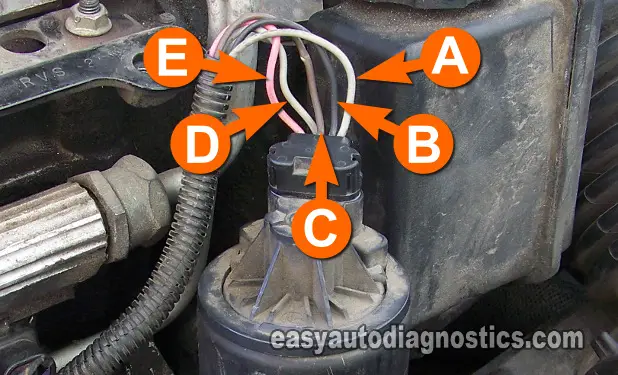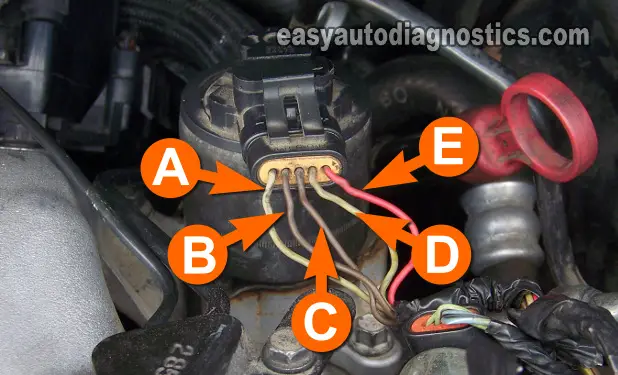TEST 5: Verifying The EGR Signal
This test step will verify that the EGR pintle position sensor within the EGR valve is working correctly. We'll do this by physically moving the EGR pintle by hand with a multimeter still connected to the EGR pintle position signal wire.
The EGR valve has to be removed from the vehicle to perform this test, so take care that the EGR valve is not hot (and if it is, take whatever precautions not to burn your fingers or hands).
- 1
Remove the EGR valve from its base.
- 2
The EGR valve, although removed from its base, must remain connected to its connector for this test.
- 3
With your multimeter in DC Volts mode, attach the red multimeter test lead of the multimeter to the C circuit of the EGR valve connector.
- 4
Connect the black lead of the multimeter to a good Ground point on the engine or the battery negative (-) terminal.
- 5
Turn the Key on but don't crank or start the engine.
- 6
With a small screw-driver, push on the EGR pintle to move it up into the EGR valve and then release it.
- 7
The multimeter should display a smooth increasing voltage reading as you push the EGR pintle up into the EGR valve.
- 8
The maximum attainable voltage, with the EGR valve's pintle fully pressed into the EGR valve, will be about 4.5 Volts DC.
- 9
The voltage reading should return to the original value, you recorded in TEST 1 (.6 to 0.9 Volts), in a smooth decreasing voltage reading as you slowly release the EGR valve's pintle back to its fully seated position.
Let's take a look at what your test results mean:
CASE 1: The voltage increased/decreased as you pushed/released the EGR pintle. This test result tells you that the EGR valve is working correctly.
The next step is to see if the EGR passages inside the plenum are not clogged. Go to: TEST 7: Clogged Intake Manifold.
CASE 2: The voltage DID NOT increase/decrease as you pushed/released the EGR pintle. This test result confirms that the EGR valve is bad. Replace the EGR valve with a new one.
TEST 6: Checking For Carbon Blockage

The next step is to remove the EGR valve from its base on the intake manifold (or the cylinder head depending on what engine you're working on). The EGR valve on your Buick (or Chevrolet, or GMC, or Oldsmobile, or Pontiac) could be very hot! Be careful not to get burned by it.
OK, once you have the EGR valve removed, it's time to visually check that the EGR valve pintle is not held open by pieces of carbon and that the orifices, of the EGR valve base, are not blocked by carbon (see the photo above).
CASE 1: If both the EGR pintle and EGR base orifices are blocked with carbon. Your next step is to remove the carbon deposits and verify that the EGR pintle can now completely seat on its seat. This cleaning should solve your EGR fault code and/or rough idle condition. Re-install the EGR valve, clear the EGR valve fault codes (that were lighting up the check engine light [CEL]), and road test the vehicle to see if the problem has been solved.
CASE 2: If only the EGR pintle was blocked with pieces of carbon from fully seating on its seat. This is a problem that'll cause a rough idle and/or engine stall condition. Removing these pieces will solve the issue. Re-install the EGR valve, clear the EGR valve fault codes (that were lighting up the check engine light [CEL]), and road test the vehicle to see if the problem has been solved.
CASE 3: If only the EGR Base orifices were blocked and/or closed off with carbon. Then cleaning and removing the carbon will renew the flow of exhaust gas into the engine (per PCM command) and your P0401 code should be solved. Re-install the EGR valve, clear the EGR valve fault codes (that were lighting up the check engine light [CEL]), and road test the vehicle to see if the problem has been solved.
CASE 4: If the EGR pintle and EGR Base orifices are NOT blocked with carbon. This the correct and expected test results. Your next step is to go to: TEST 7: Clogged Intake Manifold.
In TEST 7, you'll check that the EGR Passages inside the plenum (which are not visible to the naked eye) are not clogged.
TEST 7: Clogged Intake Manifold
If you're coming from TEST 5, so far you have verified two very important things:
- In TEST 1, you verified that the EGR valve is producing the correct voltage signal with the Key On Engine Off.
- In TEST 5, you verified that the EGR valve pintle is producing the correct voltage across the entire pintle's movement.
If you're coming from TEST 6, so far you have verified two very important things:
- In TEST 1, you verified that the EGR valve is producing a high voltage signal with the Key On Engine Off.
- In TEST 6, you verified that the EGR valve orifices, in the intake plenum, were not clogged.
The next step is to see if the EGR passage (which is not visible to the eye) inside the intake manifold's plenum is clogged. This takes a very particular test.
What you'll need to do now is to start the engine with the EGR valve off of the intake plenum. This is what you need to do:
- 1
With the EGR valve removed from the intake manifold, have a helper start the engine.
- 2
You'll notice one of two things:
The engine will start and run smoothly (as if the EGR valve where still there in its place).
Or the engine will start and idle extremely high and/or stall immediately. - 3
If the engine starts and idles very very high have your helper immediately turn off the engine.
Let's take a look at your test results:
CASE 1: If the engine started and idled smooth. Then this confirms beyond a shadow of a doubt that the EGR passages are clogged inside the intake's plenum.
This also confirms that this is the reason for diagnostic trouble code P0401.
You'll need to remove the intake manifold's plenum to physically remove this carbon blockage. I have used a piece of coat hanger wire as a snake (along with a lot of Carburetor Cleaner Spray) to remove this blockage and you'll need to do the same.
CASE 2: If the engine started and idled very high and/or stalled. Then this confirms that the EGR passages inside the plenum ARE NOT clogged.
Your next step is to check that the EGR pintle's motor is getting power. Go to: TEST 2: Testing The Power (12 V) Circuit (if the pintle's motor does not get power when the PCM commands the EGR valve to open, the EGR won't be able to).
If after checking and confirming that the EGR Solenoid (inside the EGR valve) is OK, then check out the suggestion in TEST 9: Useful Notes.



